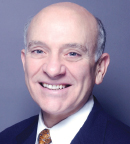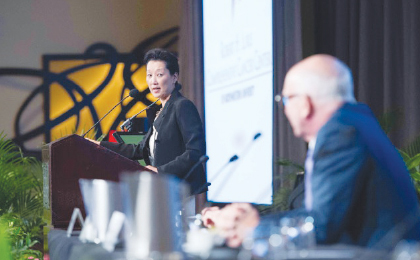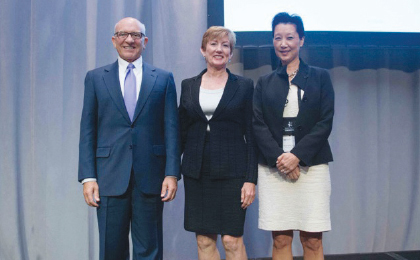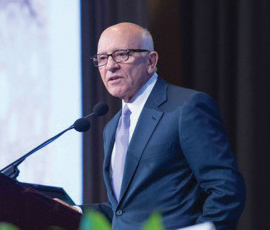
I would submit that observation without surgery is a viable strategy for ductal carcinoma in situ management for a low-risk patient population.— E. Shelley Hwang, MD, MPH
Tweet this quote
In a spirited debate, abounding with citations of clinical trials and other evidence, but not without humor and mutual respect, E. Shelley Hwang, MD, MPH, and Armando E. Giuliano, MD, reviewed the data and their clinical experience managing ductal carcinoma in situ and reached opposite conclusions.
“I would submit that observation without surgery is a viable strategy for ductal carcinoma in situ management for a low-risk patient population,” Dr. Hwang stated. Dr. Giuliano countered: “There are such tremendous problems with the omission of surgery for ductal carcinoma in situ.”
Dr. Hwang is Chief of Breast Surgery at Duke Cancer Institute, Durham, North Carolina. Dr. Giuliano is Chief of Surgical Oncology, Cedars-Sinai Medical Center, and Professor of Surgery, UCLA School of Medicine. They spoke at the Connie Moskow Memorial Debate,1 18th Annual Lynn Sage Breast Cancer Symposium, conducted by the Robert H. Lurie Comprehensive Cancer Center, Chicago. Both Connie Moskow and Lynn Sage died of breast cancer, and their families sponsor these events in memory of these women.

Do you really think if you take it out, radiate it, and give it tamoxifen, the progression rate of invasive cancer is higher than if you just leave it alone and watch it?— Armando E. Giuliano, MD
Tweet this quote
Conducting an informal audience poll before the debate began, session moderator Monica Morrow, MD, Chief of the Breast Service at Memorial Sloan Kettering Cancer Center, New York, asked: “With the exception of patients who are within danger of dying of some other disease in the next year or so, how many people here currently manage ductal carcinoma in situ, outside of a clinical trial, without any surgery?” The symposium had almost 700 registered physicians and other health-care professionals, but only a single hand was raised in response to Dr. Morrow’s question.
Uptick in Incidence
“Clearly, there was an uptick in the incidence of both ductal carcinoma in situ and invasive cancer when screening mammography was introduced around 1980,” Dr. Hwang began. “That incidence continued to rise over the next 20 years, until about the early 2000s,” when the incidence dipped then stabilized.
“Was that dip the result of increased screening? Was it the result of increased efficacy of treatments? I would argue that it is probably both,” Dr. Hwang said. The incidence of breast cancer did not decrease as much as for other cancers, for which screening strategies have been widely implemented, such as cervical and colon cancers, and for which incidence and mortality rates have dropped “pretty precipitously,” Dr. Hwang said. “Clearly, this is not something we are seeing in breast cancer, and it bears some close examination of what we are doing with increased screening and detection of ductal carcinoma in situ.”
Challenging Opposing Arguments
Dr. Hwang confronted the four main arguments often advanced by those who are not in favor of active surveillance.
1. We will miss occult invasive cancer.
“I would like to point out that there are many situations in which we leave cancer behind when we treat cancer,” Dr. Hwang stated. “When we get a core biopsy diagnosis of ductal carcinoma in situ, that doesn’t mean ductal carcinoma in situ is all the patient has.” She compared the rates of ductal carcinoma in situ upstaging for several different studies, ranging from 6% to 18%.

18th Annual Lynn Sage Breast Cancer Sympoisum. Photo by Abel Arciniega.

Armando E. Giuliano, MD, Monica Morrow, MD, and E. Shelley Hwang, MD, MPH. Photo by Abel Arciniega.
“Clearly, we are leaving invasive cancer behind if we chose not to excise ductal carcinoma in situ. That is a reasonable assumption to make. But we know that when we operate on patients with invasive cancer, most of the time, we leave some disease behind, and although it makes us uncomfortable, those are the facts,” Dr. Hwang said.
That’s where radiation comes in, she said. “When you look at patients who were enrolled in prospective randomized trials for radiation and lumpectomy vs lumpectomy alone, the absolute risk reduction in ispilateral breast tumor recurrence was about 15%” with breast-conserving surgery plus radiation therapy.
In ACOSOG Z0011,2 patients who were treated with breast-conserving surgery and had positive sentinel lymph nodes were randomized to sentinel lymph node dissection alone or axillary lymph node dissection. Among those having axillary lymph node dissection, “21% of the patients had additional positive nodes,” Dr. Hwang reported. “So by not doing axillary lymph node dissection, you are probably leaving some axillary disease behind in about 20% of patients. Despite that, when you look at the cumulative local regional recurrence rate, there is no difference in patients undergoing axillary lymph node dissection vs sentinel lymph node biopsy,” she said.
“An even more extreme situation occurs in patients who have residual axillary disease following neoadjuvant therapy. These patients generally have more advanced disease, have undergone chemotherapy, and still show they have residual disease,” Dr. Hwang said. “We acknowledge there are situations in which we leave invasive disease behind, and in neoadjuvant studies, we’re even leaving resistant invasive or metastatic invasive disease behind.”
2. Lumpectomy is not so bad.
Although most women diagnosed with ductal carcinoma in situ are treated with lumpectomy and radiation therapy, “about 20% of women undergo unilateral mastectomy, and about 10% of women undergo bilateral mastectomy,” according to Dr. Hwang. “Those are pretty aggressive treatments for something that may not have any likelihood of immediate mortality,” she added.
Pain can persist for years after breast cancer surgery. Reviewing a study by Gärtner et al,3 Dr. Hwang reported: “For patients with breast-conserving surgery and sentinel lymph node biopsy, 40% reported some pain even 2 years after surgery.” For 10% of those patients, the pain was severe, and for another 36%, the pain was moderate. Among women who underwent mastectomy and sentinel lymph node biopsy, 25% had persistent pain, 3% of those women had severe pain, and 36% had moderate pain.
“Not only is there physical morbidity, there is tremendous physic morbidity,” Dr. Hwang noted. A study among 506 women found that fear of cancer recurrence was higher in patients who had ductal carcinoma in situ than in those with stage I invasive stage, although highest in stage II patients.4 “Almost 30% of patients with ductal carcinoma in situ reported moderate or high levels of fear 2 years after surgery,” Dr. Hwang stated.
“Despite our best efforts and wanting to make things as good for our patients as we can, our interventions don’t always turn out well,” Dr. Hwang admitted. “Our reconstructions fail. Our patients develop radiation complications. Even under the best of circumstances, bad things can happen to patients.”
3. Breast cancer mortality will increase.
Using data from the Surveillance, Epidemiology, and End Results (SEER) registry, Dr. Hwang and colleagues compared breast cancer–specific survival in patients treated with either mastectomy or lumpectomy with or without radiation therapy.5 “Basically, all the curves converged,” she reported, and the 10-year disease-specific survival in all groups exceeded 98%, “which means we are just incredibly good at treating patients with ductal carcinoma in situ, or there could be a subset of women in that group who never would have died of their disease, even if we had not intervened,” acknowledged Dr. Hwang.
In his rebuttal, Dr. Giuliano pointed out that SEER also showed breast cancer mortality rates of 3.8% for patients who had neither surgery nor radiation therapy vs 1.1% with excision or mastectomy.5 “That is a big difference,” Dr. Giuliano said. “What if that were a drug” that produced “a 76% risk reduction of breast-specific mortality? That would be a blockbuster drug.”
Data on breast cancer progression and outcomes were used to develop a predictive model to determine the cumulative mortality difference for active surveillance vs usual care.6 Scenarios were modeled for women diagnosed at age 40, 55, and 70. The difference in mortality between women in the active surveillance and usual care groups “started getting smaller and smaller as the patients grew older,” Dr. Hwang said. For women at age 70, “following a path of active surveillance vs following a path of usual care, the reduction in overall cumulative mortality in 10 years is probably only about 2%,” she noted.
“Our colleagues in urology are way ahead of us on this issue. They have been thinking about active surveillance in prostate cancer for 20 years now. These data are now becoming mature,” Dr. Hwang stated. The 10-year outcomes for prostate cancer–specific survival, whether patients were randomized to surgery, radiotherapy, or active monitoring, “were exactly the same,” Dr. Hwang said, “which is what our model would predict might happen to our patients with ductal carcinoma in situ.”
4. Doctors and patients won’t go for it.
A survey Dr. Hwang and her colleagues conducted asked, Do you feel it is reasonable to offer active surveillance to some patients with ductal carcinoma in situ? Most of the 47 respondents were surgeons, with a few medical oncologists and fewer radiation oncologists. About two-thirds of respondents practiced in an academic setting, and one-third practiced in a community setting. “The majority of people felt it was reasonable in some select patient populations,” Dr. Hwang reported. “So I think the shift has already occurred, where it is no longer something that nobody would consider. Many people are interested in it.”
She also cited a TIME magazine cover story from October 2015 with the headline7: “What if I decide to just do nothing. Breast cancer’s new frontier.” “Clearly, if patients aren’t all ready there, they are certainly interested about this possibility,” Dr. Hwang said.
Active Surveillance: Not For Everyone
“We want to look at what the likelihood would be of invasive cancer events,” Dr. Hwang said, and that “depends on the patient population you are looking at.” There are patients who are “not candidates for active surveillance for ductal carcinoma in situ,” Dr. Hwang concluded. These are women who have high-grade or extensive ductal carcinoma in situ; palpable disease, or other breast signs or symptoms, such as nipple discharge; or a mass on imaging by mammography or ultrasound. “These patients are at higher risk for invasive cancer; they should not be offered active surveillance,” she stressed.
“Underlying all of this is the understanding that even if there is an increased risk of an invasive cancer diagnosis, not all of those cancers are going to kill you,” Dr. Hwang said. “There are biologic types of cancer” that would not recur at a distant site.
Offering the Option of Active Surveillance
“Active surveillance is clearly not an option that all women will embrace. It is definitely not an option that all of you are embracing currently,” Dr. Hwang said to the audience, “although hopefully that will change in the next 5 or 10 years. But I would argue it needs to be considered as an option along with the whole suite of other options we offer patients. And if that is the option a woman chooses, she should be supported in that decision, again in the context of a clinical trial. We should do our best to try to create safeguards around these patients, so they don’t develop extensive progressive disease if they were to develop invasive cancer.”
Dr. Morrow asked: “Is this an option that you offer outside of a clinical trial today?”
Dr. Hwang responded: “I have often been misquoted as saying that women with ductal carcinoma in situ don’t need any treatment, and because of that, a lot of women who have already made up their mind not to seek any treatment for ductal carcinoma in situ, they want to decline surgery, end up in my clinic.” She conducted a small cohort study with about 30 patients who have declined intervention other than endocrine therapy, taken by about half of the cohort. “I do see those patients quite frequently and try to offer as close monitoring as I can.” That generally consists of a mammogram every 12 months, alternating with breast magnetic resonance imaging (MRI) every 12 months, although some patients have a mammogram every 6 months.
“I want to emphasize I am not condoning that we offer active surveillance to all patients, but I would like to encourage the entire community to think about ductal carcinoma in situ as being very heterogeneous, and the treatments we offer patients should reflect the great biologic heterogeneity in this group of patients.”
“There are health-system trade-offs as well. Usual care annually involves performing about 34,000 lumpectomies, 23,000 adjuvant radiation therapies, 10,000 mastectomies, 4,000 bilateral mastectomies—all at the cost of about $250 million a year, and I think that is even an underestimate,” Dr. Hwang said. “The main benefit would be potentially about a 1% 10-year disease-specific mortality.”
Problems Related to Omission of Surgery
Dr. Giuliano started off by listing what he view as “such tremendous problems” with the omission of surgery for ductal carcinoma in situ: needle biopsy may fail to reveal invasion; grade is difficult to determine; disease progression to invasive cancer occurs; and morbidity of excision is low.

Armando E. Giuliano, MD. Photo by Abel Arciniega.
“Mortality is not the only important endpoint,” Dr. Giuliano reminded the audience. “I have never met a patient who is happy to hear she had early low-grade invasive cancer.”
“There is no question” that a “needle biopsy showing ductal carcinoma in situ may fail to demonstrate areas of invasion,” Dr. Giuliano said, citing six recent studies with upgrade rates ranging from 16% to 22%. “We looked at our own upgrade rate,” he added. “We haven’t published it yet, but it is 26% of ductal carcinoma in situ upgrade to invasive cancer. That is a lot of patients for whom you are leaving invasive cancer in their breast to watch it grow.”

E. Shelley Hwang, MD, MPH. Photo by Abel Arciniega.
In her rebuttal, Dr. Hwang acknowledged these comments on upstaging. “In an unselected population of women who have a core biopsy and proven diagnosis of ductal carcinoma in situ, the upstaging rate can be an issue.” By being more selective, however, and using criteria such as estrogen receptor, progesterone receptor, and HER2 in addition to some of the traditional pathologic criteria, “we can lower that rate to about 5%,” she indicated.
Grade: ‘Not a Very Good Predictor’
In one of the studies cited, Doebar et al,8 34 of 155 needle biopsy cases of ductal carcinoma in situ, or 22%, were upstaged to invasive cancer. The risk factors significantly associated with upstaging included tumor size and age ≤ 40 years, but “grade in that study was not a very good predictor,” Dr. Giuliano noted. There were only 12 low-grade specimens, and the upgrade rate was 17%. The upgrade rate was 30% for intermediate-grade specimens and 26% for high-grade specimens (P = .754). In another study, the rates of upgrade to invasive cancer were 10% for low-grade tumors, 12% for intermediate-grade tumors, and 23% for high-grade tumors.9 “Grade itself is a poor indicator of the presence of invasion. You cannot rely on grade,” Dr. Giuliano stressed.
“There is not that big of a difference between high, intermediate, and low grade on pathology slides,” Dr. Giuliano continued. Many pathology reports list “low/intermediate or intermediate/high. They don’t quite come out with what you want to hear,” he noted.
“Pathologists do not always agree on the diagnosis itself or the grade of ductal carcinoma in situ,” Dr. Giuliano added. In one study using 240 breast biopsy specimens, 42.5% excisional and 57.5% core needle, 115 pathologists each reviewed 60 samples, and their diagnoses were compared with those of a reference panel of pathologists. “The overall concordance rate on the diagnosis of ductal carcinoma in situ was only 84%,” Dr. Giuliano reported. The rate was 3% for overinterpretation and 13% for underinterpretation.10 In another study of 610 specimens of ductal carcinoma in situ reviewed by a panel of breast pathologists, only 54% could agree with the initial diagnosis of low-grade ductal carcinoma in situ. Concordance was worse, 43%, for intermediate grade but better, 80%, for high-grade ductal carcinoma in situ.11
Considering the results of these studies collectively, Dr. Giuliano remarked, “A needle biopsy diagnosis of low-grade ductal carcinoma in situ may in fact be invasive cancer or ductal carcinoma in situ of a higher grade.”
Biggest Problem Is Recurrence
“The biggest problem may be ductal carcinoma in situ can recur or progress to invasive cancer, even with excision,” Dr. Giuliano stated. “And do you really think if you take it out, radiate it, and give it tamoxifen, the progression rate of invasive cancer is higher than if you just leave it alone and watch it?”
In the EORTC 10853 trial, the recurrence rate at 5 years among women with ductal carcinoma in situ treated with breast-conserving surgery with or without radiation therapy was 16%, and nearly half of those recurrences were invasive cancers.12 In the ECOG-ACRIN E5194 trial,13 among women with ductal carcinoma in situ selected for favorable clinical and pathologic characteristics and treated with excision without radiation therapy, ipsilateral breast events occurred among 14.9%, and “half of these cancers that recur are invasive,” Dr. Giuliano said. The risk of developing an invasive cancer increased over time.
Using excision alone and a margin width < 1 mm as a surrogate for no treatment or surveillance, Khan et al found 10-year invasive recurrence rates of 26% for women with low-grade ductal carcinoma in situ and 31% for high-grade ductal carcinoma in situ.14 “That is a lot,” Dr. Giuliano said. “That is too much for me to want to leave the cancer untreated in my patient.”
Morbidity of Excision Is Low
Breast-conserving surgeries “are not morbid procedures,” Dr. Giuliano contended. “Surgical-site infections after breast surgery ranges from 1% to 3%,” he noted, and “hematoma in breast surgery ranges from 2% to 10%.”
Patients who have lumpectomies may have a scar, and the affected breast may not look the same as it did before, but most patients report good or excellent cosmetic results, Dr. Giuliano stated. Mastectomy should be reserved for patients with a large ductal carcinoma in situ, he advised. “Those are the ones most likely to harbor invasive cancer.”
Upcoming Clinical Trials
The arguments for and against active surveillance will be tested in three clinical trials, two in Europe. The only one in the United States, the COMET study is expected to open soon, according to Dr. Hwang, who is one of the investigators. “It will randomize women to two groups—usual treatment vs close monitoring—and the close monitoring patients will be strongly recommended to consider endocrine therapy.” Eligibility criteria include age ≥ 40 and grade I/II ductal carcinoma in situ without invasive cancer. Target enrollment is 900 patients. ■
Disclosure: Drs. Hwang and Giuliano reported no potential conflicts of interest.
References

